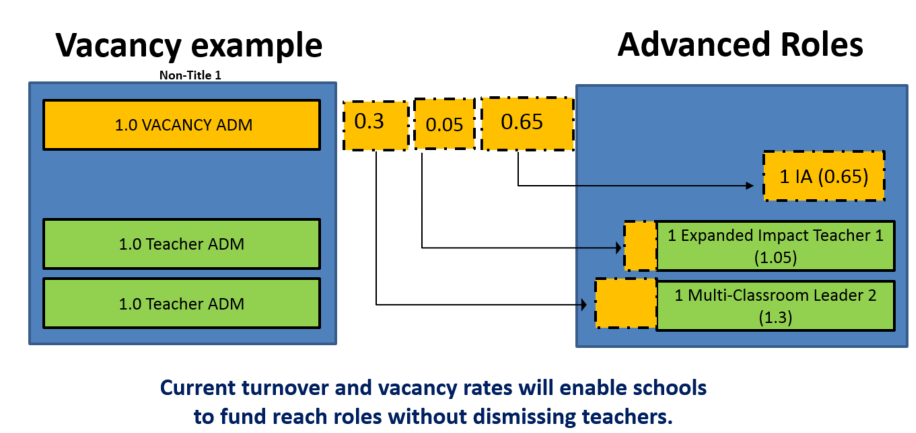Charlotte-Mecklenburg Schools (CMS), the second-largest district in North Carolina, serves more than 140,000 students across a city nestled among a network of lakes to the north and south. Both its students and its landscape are diverse. CMS students come from across the globe and speak more than 200 languages. The district is sprawling, with school buildings surrounded by a concrete cityscape, as well as schools tucked into suburban neighborhoods or reaching out into woods and farmland.
In 2013, CMS’s most vulnerable students were struggling. Children in the city’s poorest schools were graduating at far lower rates than in its more affluent schools. Achievement gaps were widening, and schools were struggling to retain effective teachers. In response, CMS turned to a strategic staffing model to attract and retain effective teachers and better serve students, becoming the first district in North Carolina to pilot Opportunity Culture. The pilot, rolled out in a handful of Title I schools districtwide, led to significant positive impacts on students and teachers. Graduation rates improved, and the initiative reduced the number of teacher vacancies in participating schools from nearly 300 in 2013 to just 5 at the beginning of the 2015 school year. Given the pilot’s success, district leadership scaled the model to more schools through a separate initiative, Success by Design. Schools participating in the program, which paid effective teachers up to $20,000 more for serving in advanced roles, also saw meaningful results: 58% of Success by Design Schools exceeded student growth benchmarks, compared to just 27% of schools statewide.
Galvanized by years of positive results, district leaders decided to expand the program even further. They merged the two initiatives in 2019 and created the Department of Teacher Leadership, which manages the “Teacher-Leader Pathway.” This program offers highly effective teachers the opportunity to take on one of CMS’s seven recognized teacher leader roles where they expand their reach by either taking on more students or leading a team of other teachers. Those who take on these expanded roles get a significant pay increase for doing so.
CMS intentionally offers flexible teacher leadership roles to provide school leaders with autonomy to innovate and reimagine how best to use the roles based on their school’s needs. Schools across the district can leverage their teacher-leaders in a variety of ways, including but not limited to:
Multi-Classroom Leadership models: Highly effective teacher leaders both teach classrooms of students and lead teams of teachers and other educational support staff. Multi-classroom leaders (MCLs) are empowered to determine how students spend time and tailor their team’s roles to their strengths. MCLs are also accountable for the outcomes of all students taught by teachers on their team.
Subject Specialization models: Teachers may specialize in high-priority subjects, while other teachers or support staff on their team support students, cover administrative duties, and more. Specialized teachers may instruct up to three times the number of students as other teachers and gain additional time for planning, etc.
Class-size Change models: Highly effective teachers may teach larger class sizes and earn more for doing so. Schools have the authority to decide which class sizes to increase and may shift students from other classrooms into classrooms led by highly effective teachers.
All teachers in the program, regardless of their specific role, are eligible for additional compensation ranging from $2,250 to $18,250 per year, depending on their responsibilities. To ensure long-term sustainability, the district covers the cost of the program within existing school budgets, leveraging existing local and state funding from the Advanced Teaching Roles programs and Title I funds when available. Principals have the flexibility to reallocate resources as they see fit. For instance, imagine a large elementary school in downtown Charlotte. The school has one teacher vacancy that it has been struggling to fill, leaving those students with a less effective long-term substitute. With the Teacher-Leader Pathway program, the school principal dissolves that vacancy and increases the size of other classrooms in the building. She uses the salary of the eliminated position to cover costs, allocating 65% to support hiring an instructional associate, like a paraprofessional, to support classroom management, and the remaining 35% to pay an expanded impact teacher and multi-classroom leader more for taking on more responsibility or more students.
Allocating Resources for Teacher Leader Roles

Source: Charlotte-Mecklenburg Schools
All teachers in the Teacher-Leader Pathway talent pool, whether or not they currently hold a teacher-leader role, can participate in training sessions on topics like time management, conflict resolution, and effective team leadership. This supports current teacher-leaders and prepares future leaders for success.
Importantly, the district also established clear guardrails to manage scaling the program while maintaining quality of implementation. Oversight by the district includes implementing a multi-step talent selection process, ensuring that only teachers who meet district benchmarks are eligible to step into teacher-leadership roles. First, teachers must apply to the Teacher-Leader Pathway Talent Pool. The district is transparent about this screening process, requiring candidates to have at least two years of experience, achieve 100% proficiency scores on leadership and instructional facilitation standards across multiple summative evaluations, submit a leadership statement, and have at least one year of student growth data. Then, once in the pool, the district empowers principals as the ultimate hiring authority for these roles, giving them discretion to select teacher-leaders from the pool of district-approved candidates. This relationship between district- and school-level leadership has allowed the program to flourish by creating universal, rigorous standards for eligibility that limit the potential for bias or principal preference in the hiring process.
Additionally, securing a role as a teacher-leader is not a “one-and-done” process. Teacher-leaders are required to renew their application every three years, demonstrating that they have maintained a consistent, positive impact on student outcomes.
The positive impacts of this work are far reaching. In addition to improving student outcomes and reducing vacancies, the program also helped CMS leadership quickly identify and develop great teachers with proven track records of success working in high-need schools, saving time and money on recruiting external candidates.
Philip Steffes, a principal at Palisades Park Elementary School, sums up the impact this work has had in his building: “I can honestly say I could not imagine working in a different school that did not have Advanced Teaching Roles, nor in a district that wouldn’t support it. This is the way of the future. This is the way to change education.”

